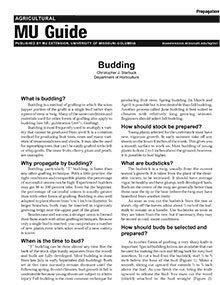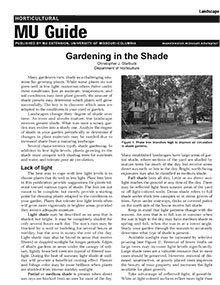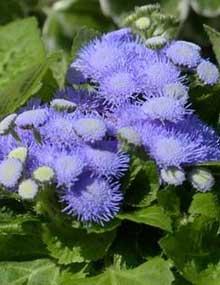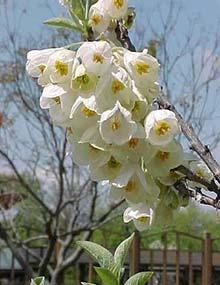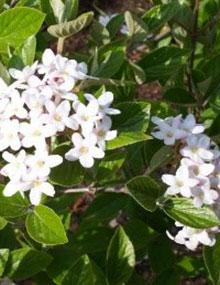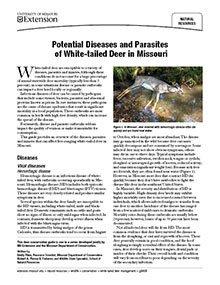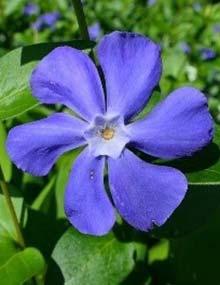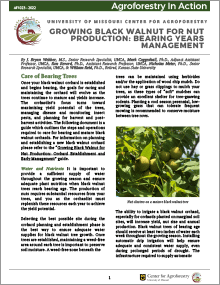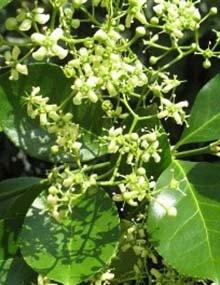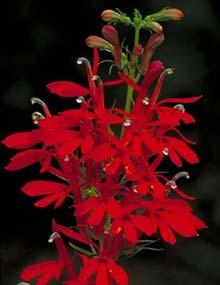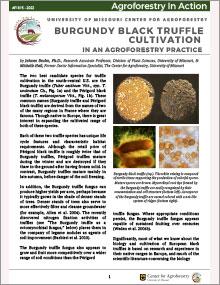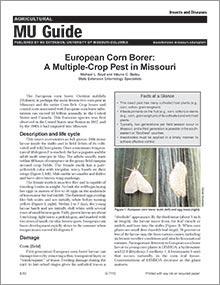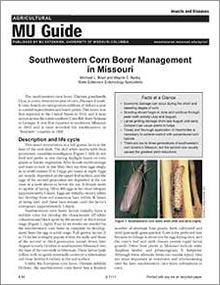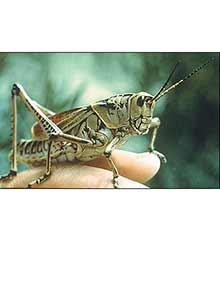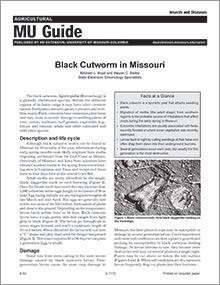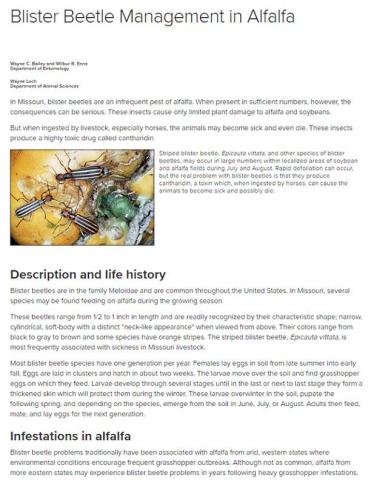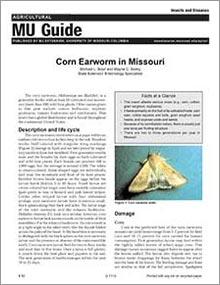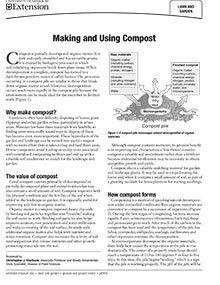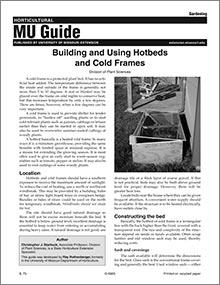Budding
Reviewed
Budding is a method of grafting in which the scion (upper portion of the graft) is a single bud rather than a piece of stem or twig. Many of the same conditions and materials used for other forms of grafting also apply to budding
Gardening in the Shade
Revised
Many gardeners view shade as a challenging situation for growing plants. While some plants do not grow well in low light, numerous others thrive under these conditions. The key is to discover which ones are adapted to the conditions in your yard or garden.
Gardening in the Shade, Page 02
Revised
Learn about these shade-tolerant annual flowers: Ageratum, Flossflower; Begonia, tuberous; Begonia, wax leaf; Browallia; Coleus; Flowering tobacco; Foxglove; Impatiens; Lobelia; Pansy; and Wishbone flower.
Gardening in the Shade, Page 05
Revised
Learn about these shade-tolerant grasses: Bottlebrush grass; Hakonegrass; Maiden grass, Silver grass; Sedge; Soft rush; Tufted hairgrass; and Woodrush.
Gardening in the Shade, Page 08
Revised
Learn about these shade-tolerant understory trees: American hophornbeam, Ironwood; American hornbeam, Blue beech, Ironwood; Carolina silverbell; Flowering dogwood; Kousa dogwood; Ohio buckeye; Pagoda dogwood; Serviceberry, Juneberry; and Sourwood, Lily-of-the-Valley Tree.
Growing Black Walnut for Nut Production: Orchard Establishment and Early Management
Revised
Eastern black walnut trees (Juglans nigra) produce high-valued hardwood products and distinctively flavored, highly nutritious, edible kernels.
Gardening in the Shade, Page 03
Revised
Learn about these shade-tolerant deciduous shrubs: Arrowwood viburnum, Bottlebrush buckeye, Burkwood viburnum, Common witchhazel, Highbush cranberry, Japanese kerria, Koreanspice viburnum, Large fothergilla, Leatherwood, New Jersey tea, Oakleaf hydrangea, Redosier dogwood, Shrubby St. Johnswort, Smooth hydrangea, Sweet pepperbush, Virginia sweetspire, and Winterberry.
Potential Diseases and Parasites of White-tailed Deer in Missouri
Reviewed
White-tailed deer are susceptible to a variety of issues. Visit our site to learn about Potential Diseases and Parasites of White-tailed Deer in Missouri.
Gardening in the Shade, Page 06
Revised
Learn about these shade-tolerant groundcovers and vines: Ajuga, Bugleweed; Boston ivy; Common periwinkle; English ivy; Epimedium, Barrenwort; Japanese spurge; Lily-of-the-Valley; Lilyturf; Lungwort, Bethlehem sage; Mock strawberry; Plumbago, Leadwort; Purple wintercreeper; Sweet woodruff; Virginia creeper, Woodbine; Wild ginger; and Yellow archangel, Dead nettle.
Growing Black Walnut for Nut Production: Bearing Years Management
Revised
Once your black walnut orchard is established and begins bearing, the goals for caring and maintaining the orchard will evolve as the trees continue to mature and yields increase. This guide outlines the steps and operations required to care for bearing and mature black walnut orchards.
Understanding Food Labels Poster
Revised $33
Learn to interpret the information shared on a food label. This poster discusses nutrients, percent daily value, serving information, and the ingredients list.
Gardening in the Shade, Page 04
Revised
Learn about these shade-tolerant evergreens: American holly; Canada hemlock; Drooping leucothoe, Fetterbush; Japanese holly; Japanese pieris; Leatherleaf viburnum; Littleleaf boxwood; Oregon grapeholly; Rhododendron; Spreading euonymus; and Yew.
Gardening in the Shade, Page 07
Revised
Learn about these shade-tolerant perennial flowers: Astilbe, False Spirea; Balloon flower; Bellflower, Campanula; Bergenia, Pigsqueak; Bleedingheart; Bugloss; Cardinal flower; Christmas fern; Coral bells, Alumroot; Cranesbill, Geranium; Hardy ageratum, Blue mist flower; Hosta, Plantain lily; Lady fern; Lady’s mantle; Ostrich fern; Toad lily; and Turtlehead.
Food Safety Poster
Revised $33
Get tips on the safe handling of food to prevent illness. This poster includes steps for proper food handling from cleaning to separating to cooking to chilling foods.
Burgundy Black Truffle Cultivation in an Agroforestry Practice
Revised
Editor's note
The following abstract describes a publication that is intended for distribution as a downloadable PDF.
European Corn Borer: A Multiple-Crop Pest in Missouri
Revised
Facts at a glanceThis insect pest has many cultivated host plants (e.g., corn, cotton, grain sorghum).It feeds primarily on the fruit (e.g., corn, cotton) or stems (e.g., corn, grain sorghum) of its cultivated and wild host plants.Typically, two generations per field season occur in Missouri, and a third generati
Southwestern Corn Borer Management in Missouri
Revised
Facts at a glanceEconomic damage can occur during the whorl and tasseling stages of corn.Scouting should begin in June and continue through peak moth activity (July and August).Larval girdling damage (from late August until early October) can cause plants to lodge.Timely and thorough application of insec
Seedcorn Maggot
Reviewed
Facts at a glance Adults (flies) become active at low temperatures (mid-40s F). Adult females are highly attracted to fields with moist soils high in organic matter or decomposing residues (animal manure or plants). The larvae or maggots burrow into the seeds of several crops (e.g., corn, soybeans), damage co
Black Cutworm in Missouri
Reviewed
Corn Earworm in Missouri
Revised
Making and Using Compost
Reviewed
Compost can improve your landscape and garden soil. Learn how to turn leaves, grass clippings and other garden refuse into compost in this University of Missouri Extension guide.
Building and Using Hotbeds and Cold Frames
Revised
A coldframe is a protected plant bed & a hot bed is basically a heated coldframe. Visit our site to learn about Building and Using Hotbeds and Cold Frames.
